MeSynth
Hazard to Others
  
Posts: 107
Registered: 29-7-2011
Member Is Offline
Mood: http://www.youtube.com/watch?v=5ZltqlVuDIo
|
|
Potassium Cyanate - Purification
Synthesis of potassium cyanate from urea and potassium hydroxide has been discussed in multiple threads but not much has been said about the
purification of the resulting cyanate. All info that I have found has been worded poorly without explanation of how the purification actually works. I
have searched for data on the solubility of urea, potassium hydroxide, and potassium cyanate but the sources I found had mismatched information. I
think the solubility of these compounds should be made clear so that we may decide the best way to purify the potassium cyanate. 
|
|
|
MeSynth
Hazard to Others
  
Posts: 107
Registered: 29-7-2011
Member Is Offline
Mood: http://www.youtube.com/watch?v=5ZltqlVuDIo
|
|
This is one of the methods I have found.
The crude cyanate is ground in the crucible and placed in a beaker. It is then mixed with an equal volume of water. The solution is made alkaline with
a few drops of aqueous K2CO3. Once alkaline the mixture is stirred at 50C until only a small amount of solids remain undissolved. The solution is then
quickly filtered at the pump to remove the solids. 50 ml of 95% ethanol is added to the filtrate and then cooled by ice. After the solution reaches
its coldest temperature and the cyanate has precipitated. The crystals are filtered at the pump and washed with ice cold ethanol.
|
|
|
jon
Hazard to Others
  
Posts: 459
Registered: 11-1-2006
Member Is Offline
Mood: paranoid distrustful apprehensive
|
|
all i did was filter and crash with ethanol there is nothing to this.
Give me librium or give me meth!
Patrick Henry....
|
|
|
Bolt
Hazard to Others
  
Posts: 188
Registered: 26-3-2007
Member Is Offline
Mood: No Mood
|
|
Post in an existing thread! Do not make a new thread if an old one will suffice!
Consult the primary literature if you are unsure of the 'best methods.' Often they will say something like, "The method of John Smith was found to be
unsatisfactory."
|
|
|
MeSynth
Hazard to Others
  
Posts: 107
Registered: 29-7-2011
Member Is Offline
Mood: http://www.youtube.com/watch?v=5ZltqlVuDIo
|
|
Was it pure after the crash? Were any tests done?
To be sure that I understand what you mean by crash.
The cyanate (compound being crashed) is taken up in enough water to disolve as much as possible. Insolubles are filtered off. The water is then boiled
off until first signs of precipitation is seen (usually as a thin solid layer begining to form). Then a few drops of water (solvent in use) is added
to disolve the precipitate. The heat is removed and ice cold ethanol (solvent of choice) is poured in causing the compound to rapidly precipitate. It
is then filtered cold and washed with a small amount of ice cold ethanol (solvent of choice) .
Would this purify the KoCN?
|
|
|
spunonrun
Harmless

Posts: 2
Registered: 6-9-2011
Member Is Offline
Mood: No Mood
|
|
urea:
Solubility in H2O (5°C): ~790g /L
Solubility in H2O (20°C): ~1000 g/L
Solubility in H2O (25°C): ~1200 g/L
Solubility in EtOH: ~50 g/L
Decomp: >132 °C
sodium cyanate:
Solubility in H2O (20°C): ~110 g/L
Solubility in EtOH (0°C): ~0.22 g/100g Solvent
Solubility in Et2O (0°C): insoluble
Melting point: 550°C
sodium hydroxide:
Solubility in H2O (20°C): ~1090 g/L
Solubility in EtOH: ~139 g/L
Melting point: 323°C
One gram dissolves in 0.9 ml water,
0.3 ml boiling water,
7.2 ml abs alcohol,
4.2 ml methanol,
also sol in glycerol
-------
synthesis and purification:
pour 10g urea and 11,5g K2CO3 into crucible
-> heat slowly with burner (H2O, CO2 and NH3 fumes evolving)
-> powder gets dry
-> apply more heat (NH3 fumes evolving)
dont heat to strong!
-> a clear molten mass shoud be in your crucible
-> let cool and crush to powder
->solve powder in min. amount of water
->add CH3COOH until no more CO2 evolves
->add two 2x EtOH (by volume)
->put in freezer
->filter out NaOCN
->rinse with EtOH (CH3COONa is removed)
Please report back when youve done.
[Edited on 7-9-2011 by spunonrun]
|
|
|
Nicodem
|
Thread Moved
7-9-2011 at 09:11 |
overload
Hazard to Self
 
Posts: 66
Registered: 9-7-2011
Location: USA
Member Is Offline
Mood: miserable fat slave
|
|
I decided to go with potassium bicarbonate.
|
|
|
overload
Hazard to Self
 
Posts: 66
Registered: 9-7-2011
Location: USA
Member Is Offline
Mood: miserable fat slave
|
|
Urea and potassium bicarbonate were reacted in a porcalin crucible with a 3 mmol excess of urea.
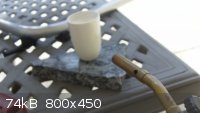
Once the chemicals liquified there was some bubbling which died down into a light fizz which got less and less until it finally stopped which signals
the end of the reaction.
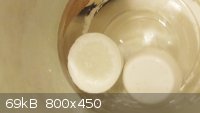
The cyanate cakes were disolved into water with heating until no more would disolve.
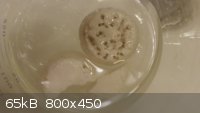
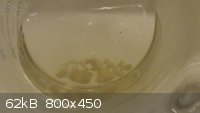
The remaining solids were filtered out and the filtrate was crashed with ice cold alcohol and the precipitates were filtered.
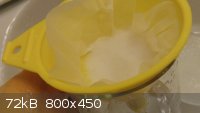
I'm certain that there are still impurities due to the filtrate forming crystals before I could crash with the alcohol. The alcohol was ice cold which
may have caused other impurities to precipitate too. When I get more 95% alcohol I will recrystalize from a supersaturated solution with warm hot
alcohol by adding it very slowly and then allowing time for the crystals to form. Then wash the filtered crystals with ice cold alcohol. I also plan
to do this in a deep sink with arm length gloves to prevent exposure to the cyanate.
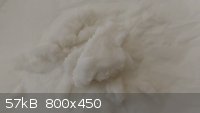
[credit | pipernigrum]
[Edited on 15-10-2011 by overload]
|
|
|
Eli25
Harmless

Posts: 8
Registered: 11-5-2015
Member Is Offline
Mood: No Mood
|
|
I react Urea with Potassium Hidroxide ....the product is black!!!! I solve it in water and filter the black substance. then evaporate the water ....a
fairly white powder remains....
If it were Potassium Cyanate it had to melt above 315 C....but it doesn't!!!!!!!!!!!!!
Has anyone have any idea?
|
|
|
Eli25
Harmless

Posts: 8
Registered: 11-5-2015
Member Is Offline
Mood: No Mood
|
|
how much Ethanol should I add? The solution itself should be warm?
|
|
|
Magpie
lab constructor
    
Posts: 5939
Registered: 1-11-2003
Location: USA
Member Is Offline
Mood: Chemistry: the subtle science.
|
|
from Inorganic Syntheses, vol II, p. 88:
"Fifty grams of finely powdered crude potassium cyanate is stirred mechanically with 50 ml of water at 50° until most of the solid has dissolved.
Glacial acetic acid (10 - 20 drops) is added until the solution is neutral to phenolphthalein. The warm solution is then quickly filtered into a 500
ml flask. 5 ml of water at 50° is used to rinse out the flask. The filtrate is treated with 250 ml of alcohol. After thorough mixing, the flask
containing the crystalline slush is placed in a refrigerator overnight. The crystals are then removed with a Buchner funnel and washed with alcohol.
The crystals must be dried thoroughly over barium oxide or a similar desiccant to prevent partial hydrolysis and the formation of ammonia on storage.
Yield is 40g (80 percent)."
For assay see my procedure in the Prepublication section of this forum.
[Edited on 4-7-2015 by Magpie]
The single most important condition for a successful synthesis is good mixing - Nicodem
|
|
|
aga
Forum Drunkard
    
Posts: 7030
Registered: 25-3-2014
Member Is Offline
|
|
Quote: Originally posted by Eli25  | | I react Urea with Potassium Hidroxide ....the product is black!!!! I solve it in water and filter the black substance. then evaporate the water ....a
fairly white powder remains |
How much Urea. What purity ?
How much KOH ? What Purity ?
How did you 'react' it ? In a solvent or by hitting it with a hammer ?
How much water ?
How white is the powder ?
How much powder ?
Is it dry powder ?
Please try to get the idea.
Chemical reactions can take many pathways depending on the relative concentrations of the reagents, any impurities, the reaction conditions, the
solvent(s) used etc etc etc.
Simply saying "I react Urea with Potassium Hidroxide ....the product is black" is no use at all.
If you can be more specific, people may be able to help more.
|
|
|